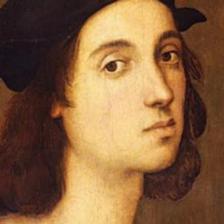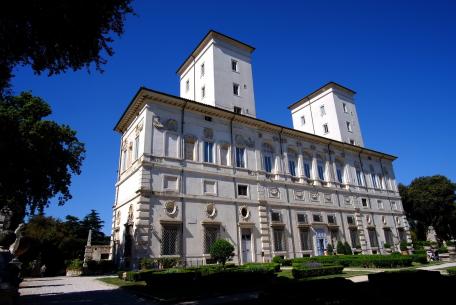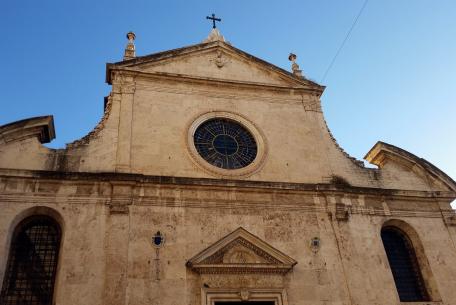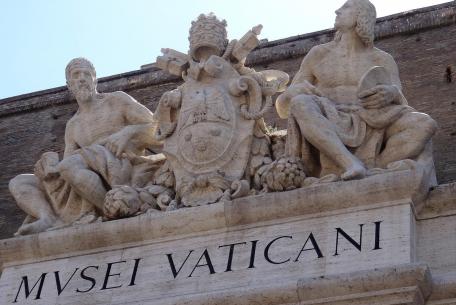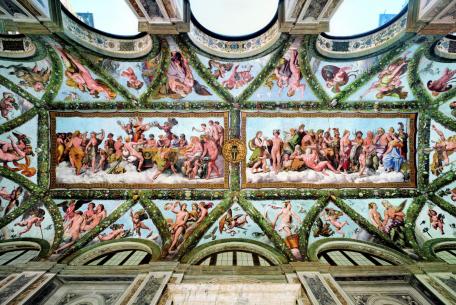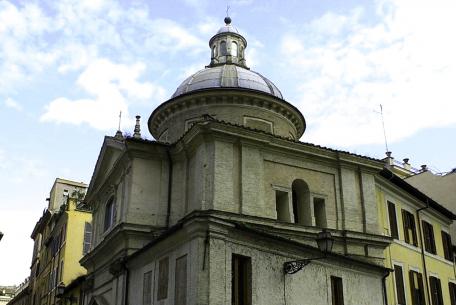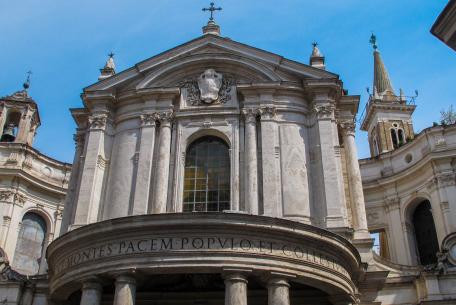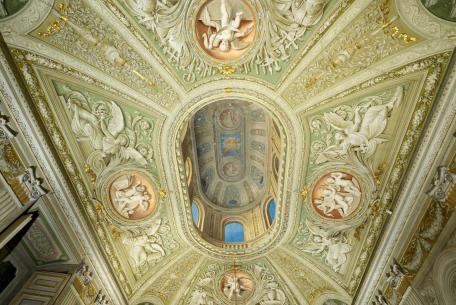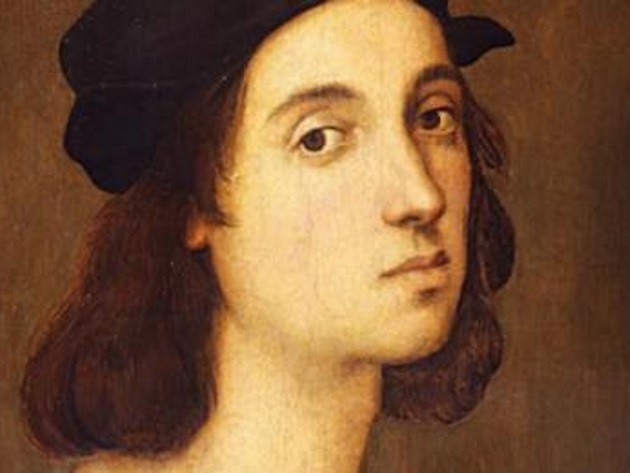
Raffaello Sanzio, also called Raphael, was born in Urbino in 1483. He was the son of Giovanni Santi, a rather skilled painter working at the court of Federico da Montefeltro. Raphael, as his father before him, started learning the art of painting by grinding up colours and training to use the paint brush. In 1494, after his father’s death, he started working at the workshop of Pietro Vannucci, called the Perugino. He learned a lot following his master in various sites of Italy between Umbria and Marche.
Raphael soon showed his artistic talent. When he was only fifteen, he made his first work Madonna di Casa Santi (1498), a fresco realized on his house wall representing the Virgin Mary with Child. It was the first of a long series of works representing the Virgin Mary. In 1499 Raffaello Sanzio already owned his workshop in Città di Castello and was commissioned quite a lot of works such as the Altarpiece of the Blessed Nicola da Tolentino, thanks to which he gained the title of “Magister”, the Mond Crucifixion (1503-1504) and the famous Wedding of the Virgin (1504). During the following years Raphael visited art cities like Siena, where he met Pinturicchio, and Florence where he painted quite a few works, among these the Madonna of the Goldfinch (1506).
Nonetheless, it was only in 1508 that he really became famous, when he was called by pope Julius II to work in Rome. Raphael was called to take part to the artistic and urban renewal of the papal city. The best artists like Michelangelo and Bramante were already working in Roma and, according to Vasari’s memories, Bramante himself recommended Raphael to the pope. He was just twenty-fifth when he came to Rome to decorate the papal apartment inside the Vatican Palace. The first room was the “Stanza della Segnatura” (initially, venue of the Supreme Tribunal of the Apostolic Signatura). Since then, he worked for many rich people, among them the pope’s banker Agostino Chigi, who commissioned him the frescoes of the loggia in the Villa Farnesina and of the Chigi Chapel in the church of Santa Maria della Pace.
In the meantime, he was working at the “Stanze Vaticane” (Raphael’s Rooms) realizing frescoes in the “Stanza di Eliodoro” and in the “Stanza dell’Incendio di Borgo”. When Bramante died, he took his place as architect in the “Fabbrica di San Pietro” and was also named “Keeper of Roman Antiquities” because of his interest in antiquities. He became the major supporter of an ideal reconstruction of ancient Rome. While working at the Vatican frescoes, he realized the “Stanza di Costantino”, then ended by his students, and his most famous works like La Fornarina, today hosted in the Barberini Palace, as well as Transfiguration, now hosted in the Vatican Art Gallery. Raphael died on the day of Good Friday 6 April 1520 after a brief disease. He is buried under the majestic dome of “all gods’ temple”: the Pantheon.
Download here the full itinerary
La Fornarina at Palazzo Barberini
No doubt, La Fornarina (1518-19) is among the most appreciated paintings by Raphael. It is housed in the National Museum of Antique Art in the Barberini Palace. The woman depicted is thought to be Raphael’s lover, but it has never been proved for certain. Vasari tells us about a certain Margherita Luti, daughter of a baker in Trastevere, that Raphael apparently loved all his life.
The author’s signature Raphael Urbinas, on the bracelet the lady is wearing on her left arm, seems to testify his love for her
Masterpieces at Galleria Borghese
Three works by Raphael enrich the Borghese collection: Young Woman with Unicorn (1505-1506), a gorgeous painting where details like the ruby and the unicorn exalt the bride’s marriage virtues and virginal candour; Portrait of a man (1503-1504), clearly showing the portrait northern techniques. The Deposition of Christ (1507) also known as Pala Baglioni, is considered Raphael’s masterpiece. According to Vasari the commissioner Atalanta Baglioni intended to homage her son murdered in 1500, with the representation of the deposition. A way to compare the noblewoman’s pain with the endless pain of the Virgin.
Cappella Chigi in Santa Maria del Popolo
The pope’s banker from Siena Agostino Chigi asks Raphael to realize a new Chapel for his family in the church of Santa Maria del Popolo. Raphael, inspired by Bramante, plans the central plan chapel and designs the sketches for the mosaics to decorate the dome, later used by Luigi de Pace.
God creator of the firmament is in the middle of the dome, surrounded by pagan gods representing the planets and the sun, dominated by angels limiting their power. The Seasons by Francesco Salviati are depicted in the rounds of the pendentives.
Masterpieces at Musei Vaticani
Raphael comes to Rome in 1508 called by pope Julius II to decorate his private apartment most important rooms, today known as Raphael’s Rooms. The “Stanza della Segnatura” (1508-1511) is the first room to be frescoed. This room takes its name from the most important tribunal of the Holy See “Segnatura Gratiae et Iustitiae”. Here the neoplatonic theme of poetry and justice in the Christian value is celebrated. It hosts the School of Athens, Raphael’s most famous work where his self-portrait can be noticed. Raphael goes on working in the “Stanza di Eliodoro” (1511-1514), where the pope holds his private audiences. The Liberation of Saint Peter is quite significant as Raphael uses new light effects in this fresco. Raphael’s art is totally shaken by the Sistine Chapel, as testified by the fresco giving the name to the “Stanza dell’Incendio di Borgo” (1514-1517), where the position of bodies and the use of bright colours are certainly influenced by Michelangelo. The “Stanza di Costantino” (1520- 24) was realized after the master’s death by his students who followed his designs.
The Tapestries (1515-1519) made in Flanders depict Saint Peter’s and Saint Paul’s stories. Initially placed in the Sistine Chapel during the solemn celebrations, today they can be admired in the Pinacoteca Vaticana (Vatican Art Gallery) also hosting the Oddi Altarpiece (1502-1503) representing the Crowning of the Virgin, the Madonna di Foligno (1502-1503) ex-voto for Sigismondo Conti’s house miraculously remained unharmed after being struck by a lightning, and the Transfiguration (1518-1520) considered Raphael’s last work. Imposingly sized it shows a complex iconography and alludes to two episodes from the Bible: the appearance of Jesus to the prophets and the episode of the obsessed child.
Raphael restlessly worked in the Vatican until 1519 when he ended the grotesque decorated Loggias (1517-1519), that connected the apartments and served as a place for conversation.
Palazzo Jacopo da Brescia
Palazzo Jacopo da Brescia (1515-19) is a nice example of the XVI century architectural style. It was realized on Raphael’s project and is a concrete example of the “Roman building” concept. It was placed at the beginning of via della Conciliazione but the original building has almost disappeared now. The ashlar facade with framed windows was dismantled and rebuilt in via Rustinucci in 1936 when Rione Borgo was restored.
Villa Farnesina
Built along the banks of the Tiber River, Villa Chigi, called La Farnesina, preserves the frescoes of the best artists of the 16th century, like Raphael, Sodoma and Baldassarre Peruzzi. Raphael’s frescoes decorate two rooms of the villa: the “Loggia of Galatea” (1511-1512) where the famous nymph Galatea is riding a shall-shaped chariot, and the “Loggia of Cupid and Psyche” (1517-1518).
The decorative theme is inspired by the work of Apuleio The Golden Donkey and by the myth of Eros and Psyche to celebrate, in particular, the forthcoming wedding between the banker Agostino Chigi, client and landlord, and Francesca Ordeaschi. The episodes of the myth are inserted in a pergola with a trompe l’oeil effect enriched with flowers, fruits and vegetables.
Sant’Eligio degli Orefici
The small size Renaissance style church was commissioned by the University of Goldsmiths and Silversmiths in Rome in 1509. Raphael, inspired by Bramante’s drawings for saint Peter’s Basilica, designed a Greek cross building, marked by pilasters. The church underwent several restorations over the centuries, but it is still possible to recognize the neoplatonic precepts inspired by the classic architecture.
Cappella Chigi in Santa Maria della Pace
In 1514 the banker Agostino Chigi asked Raphael to create frescoes in the lunette above his family chapel in the church of Santa Maria della Pace. The subject is inspired by the figures of the Sibyls and the Prophets who were the first ones to know the Messiah. The figures are organized into two groups: on the left side, we find the Cumaean Sibyl, in the act of writing on a scroll supported by an angel, and the Persian Sibyl, writing on a table “His fate will be Death”; on the right side, are the Phrygian Sibyl and the Tiburtine Sibyl on whose shoulders an angel flies bearing a scroll with the words “I will open and resurrect”. In the centre, a putto is holding a torch.
The Profeta Isaia in Sant’Agostino in Campo Marzio
It is possible to admire the fresco depicting the Prophet Isaiah (1511-1512), sitting on the throne between two putti holding a festoon, on the third left pillar of the central nave of the Basilica of Sant’Agostino in Campo Marzio, near Piazza Navona. Here, more than in other works, the strong artistic bond between Raphael and Michelangelo is clear. In fact, the peculiarity of the fresco lays in the monumentality and the bright colours of the Prophet’s figure that recalls Michelangelo’s figures in the Sistine Chapel.
Raffaello Sanzio’s tomb in the Pantheon
There is a special link between Raphael and the Pantheon, a temple during the classical age and today a minor basilica. Perhaps, not everyone knows that the famous artist is buried inside the Pantheon, under the aedicule of the ‘Madonna del Sasso’, by Lorenzetto. An epitath in Latin by Pietro Bembo pays homage to him saying: “Here lies Raphael from which, as long as he lived, Mother Nature feared to be won, and when he died it feared to die with him.”
Besides Raphael, the Pantheon houses the remains of the first two kings of the Italian Kingdom, Vittorio Emanuele II and Umberto I together with his wife Margherita, as well as the tombs of famous artists like the painter Annibale Carracci, the architect Jacopo Barozzi da Vignola, and the Baroque composer Arcangelo Corelli.
Doppio ritratto at Galleria Doria Pamphilj
One of the first examples of double portrait and the only work by Raphael hosted in Doria Pamphilj Gallery, is the Portrait of Andrea Navagero and Agostino Beazzano (1516). The characters depicted are thought to be two illustrious humanists of the pontifical court, though not all the experts agree. Placed diagonally, the two figures stand out against an emerald green background that highlights the details of the faces and the light effects used by the artist to paint their thick hair and beards.
Villa Madama
Visits allowed only with special authorization
It is worth mentioning the suburban villa among Raphael’s architectural works, known as Villa Madama, standing on the slopes of Monte Mario hill. This villa was designed as a country residence for pope Clement VII. Begun by Raphael and completed by Antonio da Sangallo il Giovane and Giulio Romano, the villa is composed of loggias, arcades, exedras, and Italian gardens creating a magnificent architectural project. Since 1937 it has been the Representative office of the Ministry of Foreign Affairs
 Condividi
Condividi












































